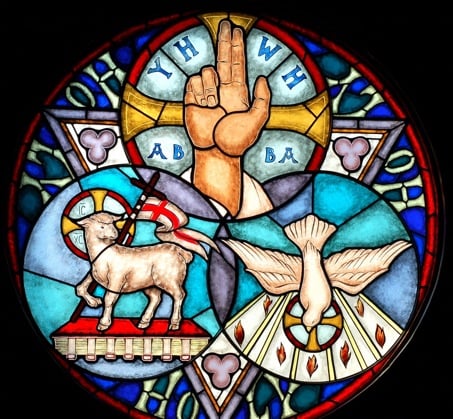The Creation Snowflake
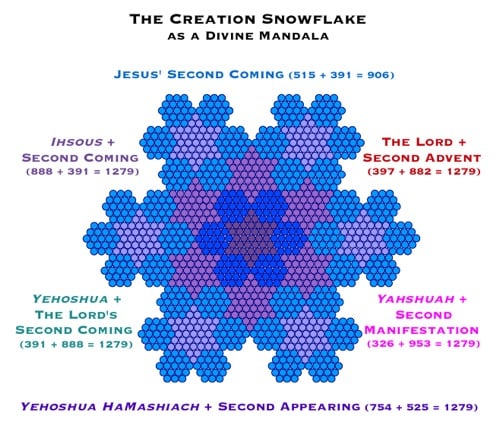
Prologue
1. In the beginning God created the heavens and the earth. 2. Now the earth was formless and empty, darkness was over the surface of the deep and the Spirit of God was hovering over the waters. (Genesis. 1:1-2, NIV)
The figure shown above, which I call the Creation snowflake, is a numerical snowflake made from 1279 discs, which represents a stage in the creation of a fractal known as the Koch antisnowflake. [1] Because the Creation snowflake is constructed from discrete units its main structural properties can be described by a set of numbers, and it turns out that these numbers are prominent in the gematria of the Trinity and the Second Coming.
This unanticipated correspondance is enhanced by the discovery of three numbers defining the Creation snowflake within the opening two verses of the NIV Bible. These verses begin the description of God’s creation of the universe, which we now know is fractal-like in its structure and for which a fractal snowflake is therefore an ideal metaphor [2]. The symbolism extends to the construction method for the snowflake implied by the encoded numbers, which repeats the six-plus-one day creation sequence described in Genesis.
The reflectivity between the numerical properties of the Creation snowflake, gematria and the subject matter of the NIV Bible’s opening statements cannot reasonably be expected to have occurred by chance, therefore this phenomenon appears to be the result of intelligent design.
For a brief introduction to snowflakes—real, fractal and numerical—please click here.
For a brief introduction to gematria please click here.
The Creation: 1
Exodus. 20:11 (NIV)
For in six days the Lord made the heavens and the earth, the sea, and all that is in them, but he rested on the seventh day. Therefore the Lord blessed the Sabbath day and made it holy.
According to Genesis 1 and the above succinct passage in Exodus, the Lord created the heavens and the earth in six days then rested on the seventh day. This day He blessed, conferring special status on it. Starting from these numbers I will show how a visual metaphor for creation ex-nihilo can be conjured, using a process of seeded growth that produces increasingly accurate approximations of the Koch Snowflake and that imitates the growth of real snowflakes.
1. The Six Days of Creation
The six days of Creation have been symbolised by a hexagonal ring of units.
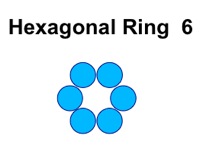
In arranging six units into a ring we create a ‘free’ space within it, an arena for further creation.
2. The Seventh Day
The 'free' space can then be filled or seeded with another unit, to create centred hexagon 7, representing the completed seven-day period.
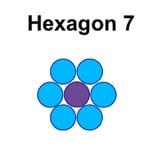
The ‘free’ unit represents the seventh day, the day of rest. So hexagon 7 serves as a visual metaphor for the completed week of Creation. [3]
Nature builds larger structures from smaller ones, using atoms to build molecules, some of which can grow into snow crystals, which accumulate to form snowflakes. Taking nature’s economy and elegance as our example, we can use the hexagon we created as the ‘day’ unit for a second illustration of the six-day Creation period.
The Creation: II
1. The Six Days of Creation
Returning to the original ring of six units, if we replace each single unit with hexagon 7 itself, we create a ring of hexagons.

We now witness an interesting phenomenon: the space in the centre takes on the shape of a hexagram.
2. The Seventh Day
The shape that completes this version of the first week of Creation is centred hexagram 13, the smallest hexagram that can be created from discrete units.
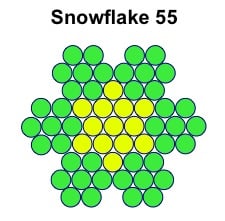
Recall that the seventh day was blessed by God and made holy. This special status is perfectly symbolised by the Star of David, an ancient symbol of Christ and modern symbol of Judaism. Thirteen, in addition to being a hexagram number and the first approximation of the Koch snowflake in numerical geometry, is also the gematria of a Hebrew word for love: ahavah. 13 x 2 is 26, the value of YHVH in Hebrew and the ordinal value of 'God' in English. Therefore in filling the ring with hexagram 13 we are symbolically infusing it with God’s love. [4]
Using the simplest possible materials and inspired both by the biblical account of creation and by nature’s snowflakes, we have created the first centred hexagon and centred hexagram numbers and a fractal snowflake. The snowflake is a perfect symbol of growth from a central point or seed and thus represents the initial moments of Creation, described in Genesis 1. In the third and final exercise we will create a larger snowflake, then cause it to grow just like a real snowflake by continually repeating the ‘creation function’, on the resulting figure. This iterative process will generate increasingly accurate approximations of Koch snowflakes and antisnowflakes, culminating in the Creation snowflake.
This is where the miracle begins.
The Creation: III
1a. Snowflake Ring 114
For the first two representations of the six days of creation, we used first a single unit then a hexagon with 7 units. These are the first two members of the centred hexagon series. The third member of this series is hexagon 19, with which we now create a third ‘six-day’ ring. It should be noted here that in biblical numerics 19 is the number of physical manifestation, which is precisely what we are concerned with here.
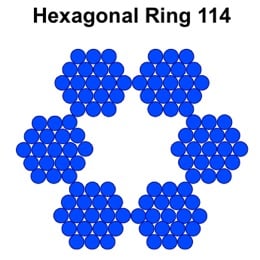
114 units are required to create this ring, which, because its constituent plates are in contact with each other, can be regarded as a single figure. 114 is the combined value of this word: [6]
God (c) = 114
The enclosed space is now definitely shaped like the Star of David. The figure that fits inside is hexagram 37.This sits at the centre of the Creation snowflake, a beautiful visual metaphor for God’s love, at the centre of our being. Appropriately, 37 is the reduced value of two words that are virtually synonyms for love.
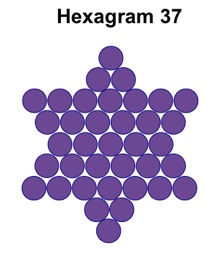
Spirit (r) ..........= 37
The Lord (r) ....= 37
It is also singularly appropriate that 37 units can be organised into the sacred symbol of the Star of David, itself the first iteration of the Koch Snowflake. It can also be considered to be the ‘seed’ from which the Creation snowflake grows.
1b. Snowflake 151
If we now place the hexagram within the outer ring of 114 units we obtain a rather beautiful snowflake, built from 151 individual units. This gives us the ordinal values of the second and third Persons of the Trinity! [7]
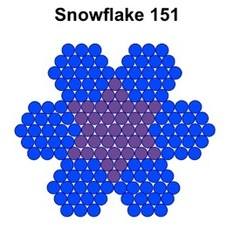
Jesus Christ (o) .................= 151
Holy Spirit (o) ....................= 151
If hexagram 37 could be called the seed for this snowflake sequence, snowflake 151 is the first generation figure. Now I am going to grow larger snowflakes by repetitions (iterations) of the process illustrated above, using the completed figure at each stage as the central snowflake for the next generation. In doing so I will create a sequence of snowflakes that are visual metaphors for God’s ongoing creative activity.
2. Snowflake 373
Snowflake 151 can be surrounded by six hexagrams, identical in size to its central hexagram (they do not touch each other and therefore do not make a figure in themselves). These stars surround the figure like a celestial garland, or perhaps like a crown of thorns. The garland is made from six hexagrams of 37 units, making 222 units in all. [8] Inserting snowflake 151 into the central space, which again completes the seven days of Creation, produces a larger snowflake, having 373 units.
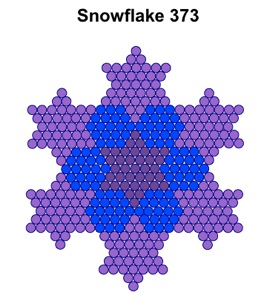

‘Logos’ translates as ‘word’ and the Incarnate Word is of course Jesus Christ, therefore it can be no coincidence that snowflake 373 contains snowflake 151, which represents his name. [7] Snowflake 151 in turn encompasses hexagram 37 (the Lord (r)), so we have a trio of nested figures, the seed and the first two generations in the growth of our snowflake, that are firmly linked through gematria and the symbolism of the Star of David to Jesus Christ.
I think you’ll agree that we now have a figure resembling a real snow crystal. The symmetry of these surface features is matched by the numerical symmetry of the palindromic numbers represented by the inner snowflake (151) and completed figure (373). These features combine to make snowflake 373 a unique geometric object and an ideal symbol of divine harmony and perfection.
3a. Snowflake Ring 906
Six versions of snowflake 151 form an elaborate diadem of 906 discs, illustrated below.
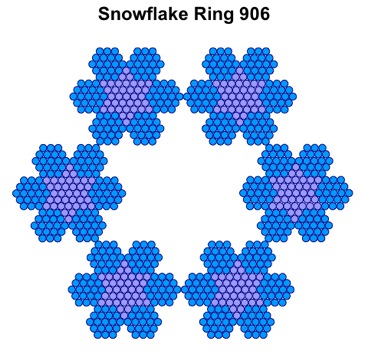
906 is the summed standard values of the word 'Jesus' in English and Hebrew:
| Jesus (s) | = 515 |
| Yehoshua (s) | = 391 |
| Sum | = 906 |
3b. Snowflake 1279
As the snowflake grows by accretion, it reveals ever more wonders. By filling snowflake ring 906 with snowflake 373, a magnificent figure, comprising of 1279 units, is created. This is illustrated below.
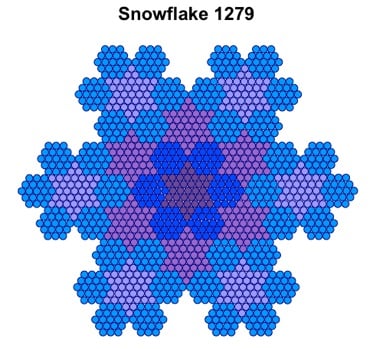
This dazzling figure is the completed Creation snowflake, and it is impregnated with the divine watermark of the Creator Himself:
The Almighty God (s) ..................= 1279
I indicated above how snowflake ring 906 is associated with the standard values of the English and Hebrew words for ‘Jesus’. Amazingly, 1279 is the sum of the standard values of the Greek and Hebrew words for Jesus!
| Ihsous (s) | = 888 |
| Yehoshua (s) | = 391 |
| Sum | = 1279 |
It follows that 1279 is also the sum of the standard values of three words associated with our Lord in English, Greek and Hebrew.
| Jesus (s) | = 515 |
| Yehoshua (s) | = 391 |
| Logos (s) | = 373 |
| Sum | = 1279 |
Completing the ‘round robin’ of additions we obtain the sum of the standard values of the English and Greek words for Jesus, which is 515 + 888 = 1403. Around 2007, I noticed that this is the standard value of the name I gave to the snowflake.
The Creation snowflake (s) = 1403
This was not by my own design! I named the snowflake around 2003, before I put up the first version of this page.
An Outline of the Creation Snowflake
For the frosting on the cake we turn now to the outline of the Creation snowflake. This defines its characteristic shape and gives rise to another number. With sublime economy of material, the Miracle Maker has utilised this very number to lead us back to the prologue of Genesis where we began.
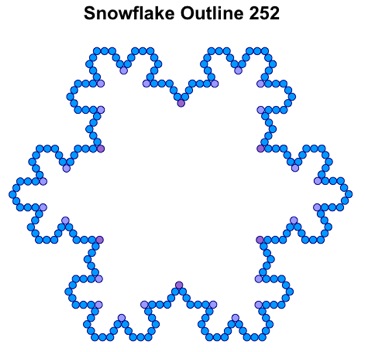
“In the beginning God created the...” = 252
These are the six opening words of the NIV Bible and their ordinal value, 252, is the first of three numbers defining the Creation snowflake which have manifested within the NIV Bible’s opening words. The first eighteen words sum to 906, which gives us snowflake ring 906. What about the completed figure? It is right under our feet, carpeting the second verse of the NIV Bible. These three encodings are tabulated below:

So numbers representing the complete Creation snowflake and two of its major structural properties are encoded within the first two verses of Genesis, in words describing God's creation of our material universe. A fractal is the perfect image to represent creation, since so many material objects - for example, clouds, trees, coastlines, galaxies and of course real snowflakes - can be approximated in fractal geometry.
The numbers defining its outline (252) and its outer ring (906) confirm, therefore, that snowflake 1279 must be the figure intended. They also highlight the internal structure shown here, the very structure that emerges from the ‘creation function’ I applied earlier! Therefore both snowflake and construction method are neatly encoded. There is also a suggestion here of gradual manifestation as we proceed from word 1: the outline and outer ring manifest before the complete snowflake.
Two of the numbers proceed from the first word, a very unlikely occurrence, since the odds against any number appearing as a word string beginning at word 1 are about 1 in 45 (about the same as the odds against drawing a named card from a pack). The chances of all three numbers appearing together in a fairly tight cluster at the beginning of the NIV Bible are much smaller.
The Creation Snowflake in the Garden
The first five verses of Genesis describe the first day of Creation and form a self-contained whole. In the NIV these verses, which I now call the Garden, are heavily-encoded with numbers that amount to an authenticating watermark on the code, and summarise its message. The Creation snowflake encodings are an integral part of this watermark, showing that Genesis 1.1-5 is no wilderness of words but has been landscaped by a divine Gardener.
For example, the following table shows the integration of the Creation snowflake with the Signature of Christ.

The above table hints at another impressive feature of the encodings: the use of the number six as a unifying motif. We note that the Creation takes place over six days, that the Signature of Christ phenomenon contains six numerical signatures, that the Creation snowflake has six sides and that it is grown by a six-plus-one process that mirrors the Creation Week and mimics the growth of real snowflakes.
The number six weaves this incredible tapestry of encoded numbers into a meaningful whole by integrating the Creation snowflake with the Signature of the Creator, and by linking snowflake and signature to the Creation story itself.
The Genesis of the Creation Snowflake
As I said, snowflake 1279 is an approximation of a Koch antisnowflake and this figure can be generated from triangle 2278, as the internal antisnowflake created along with the Koch snowflake proper, or, from hexagon 1519, as the second iteration of the antisnowflake it generates. Both figures are shown here.
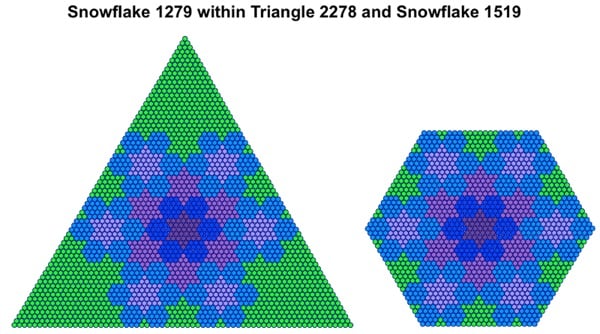
Drawing snowflake 1279 within triangle 2278 isolates several areas near each vertex of the triangle, coloured green. These shapes sum to 999 units, or 333 units at each vertex. In Hebrew, 333 is the gematria of the following word:
Shalag/snow (s) = 333
So the appearance of the Creation snowflake within triangle 2278 creates three numbers representing 'snow', suitable ornamentation for the snowflake itself - and surely by design!
Incredibly, both generating figures - triangle 2278 and hexagon 1519 - are found within the Garden, alongside the snowflake to which they give birth. Moreover, there are three instances of the number 333 within the Garden too, reflecting the three arrowheads in triangle 2278!
All of this information is shown below in the next table.

I stated that the Creation snowflake can be created as the internal antisnowflake generated when a Koch snowflake is created by self-reflection. The antisnowflake can also be directly created from a triangle by an inversion of the proceedure creating a snowflake - ie, by subtracting triangular chunks instead of adding them. Step one of this process creates a trefoil (analogous to the creation of a hexagram as the first stage of a Koch snowflake). In The First Day I show that the Garden is planted with trefoils at either end ('trefoil' means 'three-leaved plant') and is saturated with trefoil-generating triangles. So antisnowflakes are another unifying theme in the Garden.
The Creation Snowflake and the Second Coming
The three numbers 1279, 906 and 252 are all prominent in the gematria of the Second Coming.
| The Second Coming of Christ (o) | = 252 |
| Jesus' Second Coming (s) | = 906 |
| The Lord + Second Advent (s) | = 1279 |
| Ihsous + Second Coming (s) | = 1279 |
| Yehoshua HaMashiach + Second Appearing (s) | = 1279 |
| Yehoshua + The Lord's Second Coming (s) | = 1279 |
| Yahshuah + Second Manifestation (s) | = 1279 |
Ihsous and Yehoshua are the Greek and Hebrew words for Jesus (transliterated into English here). Yehoshua HaMashiach means 'Jesus the Messiah'. Yahshuah is a form of Yehoshua used by Renaissance mystics. The Creation snowflake, therefore, integrates with the rest of the New Bible Code in proclaiming the Second Coming of Jesus Christ. Along with the September-11 Cube, it can be regarded as a visual symbol of this wondrous Event, which is why I call it a divine mandala.
If there is a line between coincidence and synchronicity, between chance and purpose, then we crossed it long ago, and have now wandered into an enchanted realm where miracles occur. But unlike weeping statues and ephemeral apparitions, this miracle is frozen in time and can therefore be witnessed by all who care to do so.
Epilogue
The Creation snowflake primarily stands as a symbol of the Second Coming of Jesus Christ, which is the overall theme of this website. The Second Coming is the Manifestation of Christ on Earth, symbolised by the crystallisation of the Creation snowflake within the NIV Bible - a phenomenon which is itself part of the Second Coming. The first stage in the production of a Koch snowflake from a triangle is the Star of David, which also symbolises the joining of Heaven and Earth and which has been utilised elsewhere in the code.
The snowflake and its outer ring are the sum of the six pairings (there's that number again) of names and phrases in English, Hebrew and Greek that proclaim the Second Coming. The improbability of so many such phrases reflecting the Creation snowflake in their numerical values indicates that the gematria of these names and phrases must have been divinely guided to conform to the structural properties of the snowflake. The Second Coming has been a long time in preparation.
The Creation snowflake is a kind of geometric mandala, symbolising God’s immanence within our universe of manifest forms. Creation is full of forms that adhere to the laws of fractal geometry, as is seen most delightfully in snow crystals, which display myriad variations on the Koch snowflake. Snow crystals are therefore the perfect symbol of God’s Creativity. Every branch and platelet of the Creation snowflake bears the signature of the Creator Himself, whose formation of the universe is described in the very passage within which the snowflake has crystallised, and whose signatures are strewn throught these same words.
The Creation snowflake has therefore communicated to us in a unique and memorable way that the Creator of this universe is the God of the Judaeo-Christian scriptures, and that His Son is now returning in glory. The snowflake’s crystallisation within the NIV also signals further encodings within this version and is an authenticating watermark on the Christian Bible itself.
Words fail me in attempting to fully communicate the magnificence of the Creation snowflake; I can only turn to the Bible and quote the opening words of Psalm 105—this time from the KJV Bible—which convey the wonder of it far more effectively than could I:
“O give thanks unto the Lord; call upon his name; make known his deeds among the people.
Sing unto him, sing psalms unto him; talk ye of all his wondrous works.”
Psalm 105 v.1-2 (KJB)
Addendum (22/3/20)
I recently found that the Creation snowflake perfectly accommodates a star hexagram (a hexagram based on a centred triangle) of 925 units. This is the standard value of 'Jesus Christ', which adds further lustre to the Creation snowflake. The units left behind when the star hexagram is removed sum to the standard value for 'God', 'the Good' and 'the Holy' in Greek!
The background hexagon is a template I call 'the Lily Pad' and which will be the subject of forthcoming pages. Note that the Creation snowflake fits perfectly inside the largest star hexagon (hexagons based on centred triangles) that fits inside the Lily Pad, which has 2071 units. The Lily Pad itself is hexagon 2977 and when star hexagon 2071 is removed 906 units remain - the number of units in the outer ring of the Creation snowflake!
The Creation Snowflake and Star Hexagram 925 Within the Lily Pad
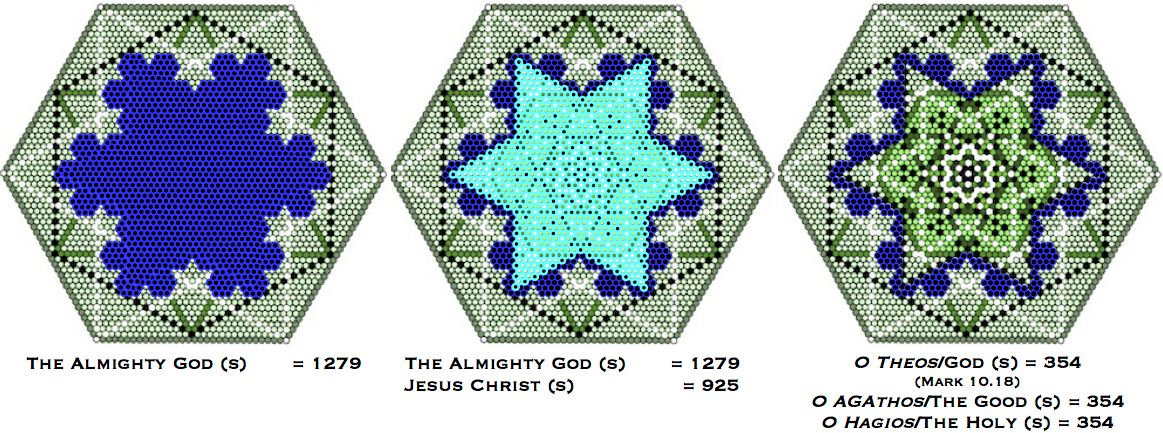
Further Reading
Christ’s Snowflakes displays further numerical snowflakes that can be created from gematria related to the name 'Jesus Christ'.
Bill Downie 14/3/05
Latest update 22/3/20
Notes
1. This is the second figure created by the iterative process that generates a Koch antisnowflake from a hexagon.
2. At the time the NIV Bible was being translated, the 1970s, the fractal-like properties of our universe would have been virtually unknown outside the mathematical community.
3. This metaphor is found in Jewish mysticism (Kabbalah). The hexagonal ring enclosing a circular space is reminiscent of the Ein Sof (the Limitless), which “withdrew itself into its essence, from itself to itself within itself”, to create a spherical primal space, into which it emanated to begin the evolution of the universe we know, symbolised by the seventh disc. Seven is an important number for the authors of the Bible, who considered it to be the most auspicious of numbers, standing for spiritual perfection. Consequently, seven is woven into more biblical passages than any other number. See The Essential Kabbalah, by Daniel C. Matt, and The Secret Doctrine of the Kabbalah, by Leonora Leet.
4. The idea that God’s love permeates the universe has some support in the work of Japanese researcher Masaru Emoto, who has spent many years freezing water then photographing the water crystals as they form. The unique feature of his work is that before he freezes the water he first projects thoughts onto it. Pure, unpolluted water or, alternatively, water onto which loving, peaceful thoughts were projected, crystallised into perfect symmetrical forms, identical to snow crystals. Water subjected to angry or hateful thoughts crystallised into irregular forms or not at all. Polluted water also refused to crystalise. However, when a body of polluted water was prayed over, it too formed regular crystals upon freezing.
6. It should be borne in mind, however, that the combined system is tentative and has no precedent in Hebrew or Greek gematria. Interestingly, the ordinal value of the phrase ‘the Tabernacle’ is 114! Other related phrases with an ordinal value of 114 are ‘the source’ and ‘the beginning’.
7. Astoundingly, several well known phrases that are meaningfully related to Jesus Christ have ordinal values of 151: ‘Jesus is Lord’, ‘The Incarnation’, ‘Christ the King’, ‘The sacrificial lamb’. Snowflake 151 (and indeed the entire Creation snowflake) is built from two related figures: the hexagon and the hexagram. These words may themselves be encoded with the same numerical signature, because the ordinal values of ‘hexagon’ and ‘hexagram’ are 74 and 77, the same as ‘Jesus’ and ‘Christ’. So Christ’s English name could be said to be inscribed on every branch and platelet of the Creation snowflake!
8. I thank Richard A. McGough for discovering the link between snowflake 373 and the Greek word logos. The reduced, ordinal and standard values of the name ‘Jesus Christ’ are 43, 151 and 925. The combined value of 1119 is simply the sum of these three values, of course, and is therefore 373 x 3.
